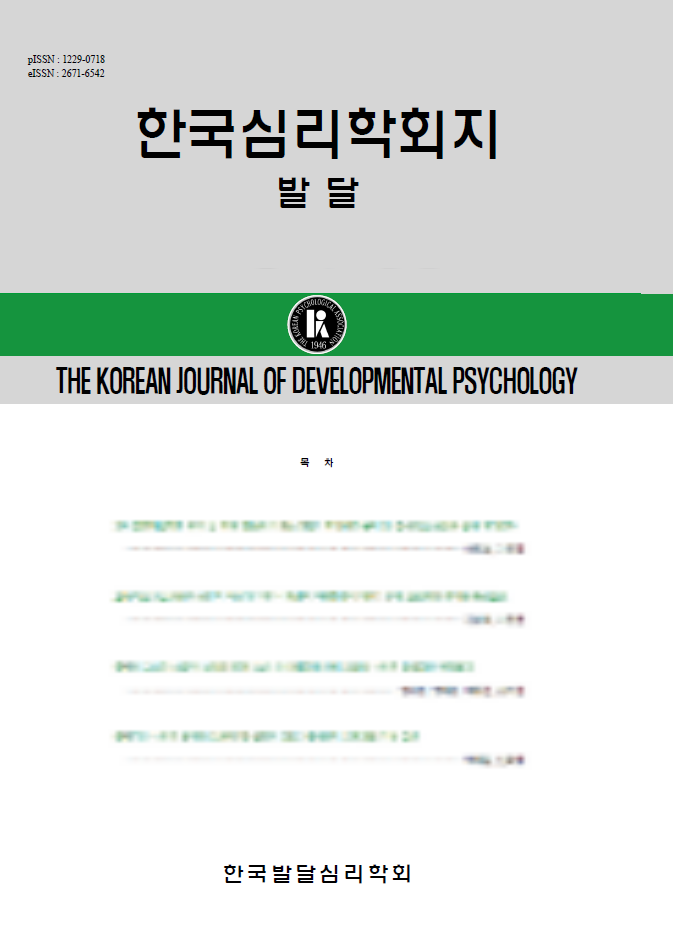open access
메뉴
open access
메뉴 ISSN : 1229-0718
ISSN : 1229-0718
본 연구는 유아의 일상적 스트레스 척도를 개발하기 위한 예비연구에 대한 후속연구로서 척도개발을 위한 최종문항을 추출하고 그에 대한 신뢰도와 타당도를 검증하는 데에 목적이 있다, 예비연구에서 이미 유아의 일상적 스트레스 척도의 개발을 위해 31개 문항이 선정되었었으며 '불안좌절감', '자존감 상함' '비난 공격적 상황에 접함'의 3개 요인이 추출되었었다. 예비연구에서 선정된 31개 문항에 대해 예비연구 때와 동일한 방식으로 3-6세 유아 554명에게 본검사를 실시하였고, 유아의 담임 교사로 하여금 아동 행동을 관찰 평가하도록 하였다. 척도의 신뢰도는 전체 a= .80이었으며, 각 요인별로는 .62, .68, .66을 나타내었다. 척도의 타당도 검증을 위하여 내용 타당도, 구성개념 타당도를 살펴보았다. 내용 타당도는 수차례에 걸쳐 전문가에 의해 검증되었다. 구성개념 타당도 검증을 위해서는 요인분석, t-검증을 실시하였다. 요인분석 결과 예비 연구 결과와 동일하게 유아의 일상적 스트레스 척도의 요인으로 3개 요인이 추출되었으며, 문항수는 31개에서 23개로 축소되었고 전체 설명분산 값은 79.73%를 나타내었다. 요인 간 상관계수는 .45, .52, .26을 나타내었다. 척도의 구성개념 타당도 검증을 위해 집단 간 차이검증을 t-검증으로 실시한 결과, 정상 가정 유아 집단과 결손 가정 유아 집단 간에 유의한 차이를 나타내었다(p<.001). 본 연구는 국내에서 아직 제작되지 않은 학령 전 유아의 일상적 스트레스 척도를 개발하였고 그 타당도를 검증하였다는 점, 그리고 유아가 직접 응답하는 체계로 척도를 제작하였다는 점에서 그 의의가 있다. 추후 연구에서는 본 연구에서 제작한 척도의 신뢰도와 타당도를 재검증하기 위한 계속적인 연구가 필요하며, 보다 많은 유아를 대상으로 하여 본 연구에서 개발한 유아의 일상적 스트레스 척도에 대한 표준화 작업이 이루어져야 할 것이다.
The purpose of this study, as a following study of the pilot test which develop preschool children's daily stress scale, is to develop final items for scale development and verify its reliability and validity. From the pilot test, "experience anxiety-distress*7, "hurt pri.de",and "encounter criticized-violent situation" were found as three factors and 31 items were already selected.. Using the same method as the pilot test, the finally selected final 31 items were tested by 550 preschool children (age 3-6). The teachers of those children's were asked to observe their students' behavior and provide their professional evaluation. The reliability of the scale was the total a =.80 and the calculation for each factor was .62, .68, and .66, respectively. To verify the validity of the scale, content validity, construct validity, and criteria-related(concurrent) validity were tested. The content validity was verified several times by professional. Factor analysis, t-test were used to verify construct validity and factor analysis was proved to be similar to that of the pilot test which resulted in the same three factors and the number of items was further adjusted to 23, and the total explained-variable value was 79.73%. Inter-factor correlation for the three factors was measured at .45, .52, and .26, respectively. To verify the content validity of the scale, the t-test was conducted between a group of/ children from normal-family preschool children group and a group of children from single-parent preschool children group, and the difference between a group of children who showed normal-children group and a group of children who showed clinical-children group, and the result was significant(p<.001, p<.01). This study was significant in that this was the first preschool children's daily stress scale developed yet in Korea with the direct response and input from Korean preschool children. Further study and research to re-verify the scale developed by this study may be necessary. Also, more field testing of the scale developed by this study through a greater number of preschool children is needed to achieve the standardization of the newly developed scale.
